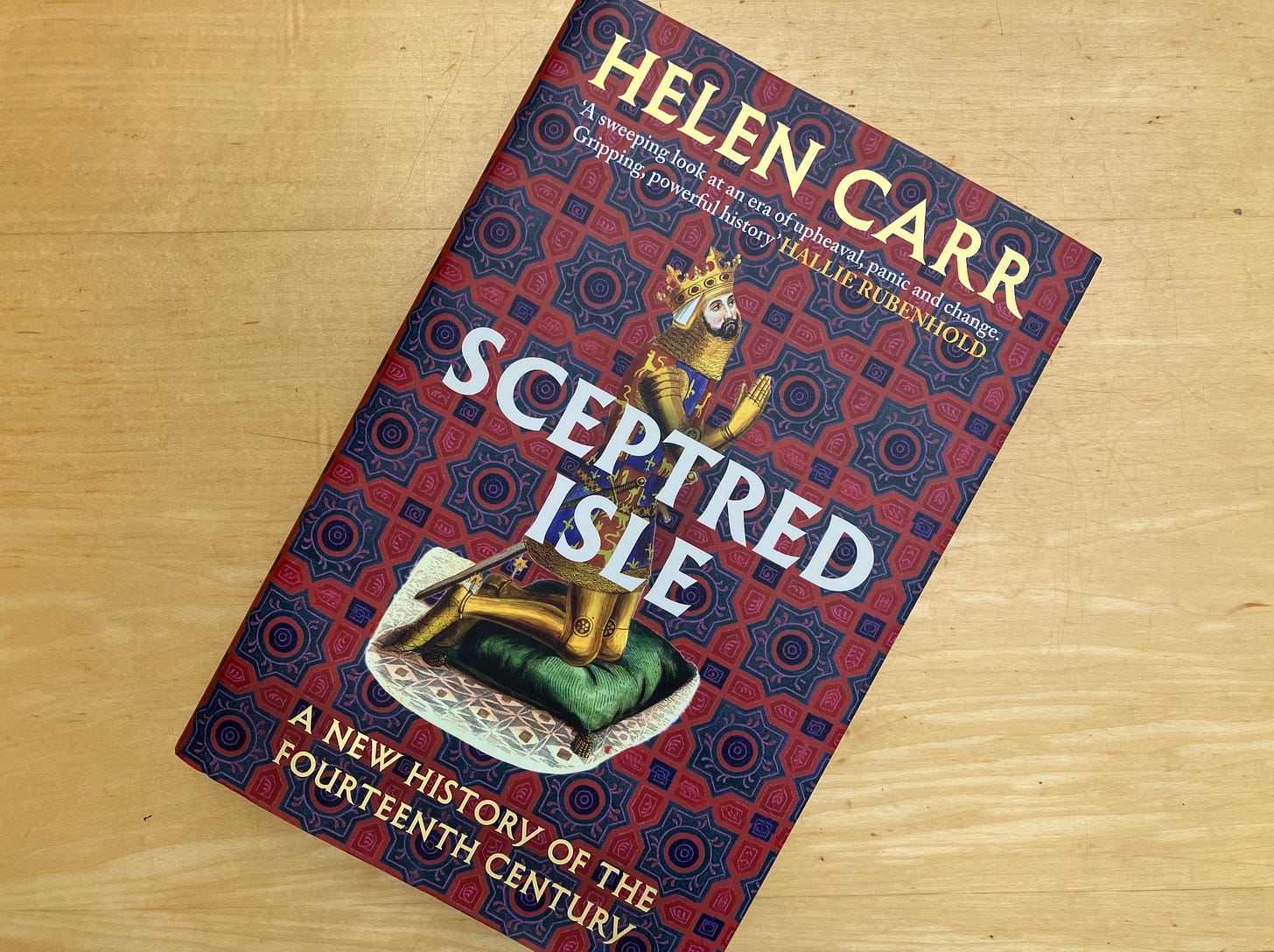Review: Sceptred Isle by Helen Carr
A powerful new account of English history in the tumultuous fourteenth century
In the early 1370s, Louis I of Anjou, the second son of the French king, commissioned a vast series of tapestries, now on display at the Château d’Angers, representing the Book of Revelations. In the middle of the narrative is a group of men on horseback wearing distinctively English armour; one wears pheasant feathers in his helmet – another mark of English soldiery. As for the Apocalpyse itself, its horsemen were led by Edward III.
Edward’s 50-year reign dominated 14th-century England. But, as we see in Sceptred Isle, Helen Carr’s gripping narrative account of the period, Edward himself was dominated by the dream of taking the French crown. It led him to launch two great invasions, one in 1346 and the other in 1359. It is not hard to understand why the French experience of English armies was something like the end of world. According to one chronicler: ‘The English destroyed, burned and plundered many little towns, capturing or even killing the inhabitants.’ Cernay was reduced to ashes. The people of Orly were massacred in their parish church. There were many Cernays and Orlys. But Edward failed to take Reims where the kings of France had been crowned for centuries. He never attempted Paris.
Between Edward’s two invasions both countries – and the whole continent – were ravaged by another apocalyptic phantasmagoria in the shape of the Black Death. In the space of a couple of years at the end of the 1340s it killed around half the people in Europe. In London, they buried 200 corpses a day; in St Albans there weren’t enough living to bury the dead. The nobility quarantined themselves in their castles, but what contemporaries called ‘the Great Death’ could not be outrun: Edward’s beloved teenage daughter Joan died of it in English Bordeaux. Carr describes how Edward, touring the west of England afterwards, found a kingdom transformed, as if woken from a nightmare into a wild new world full of foreboding: ‘Homes were entirely abandoned, fields unsown and unploughed, crops laid to waste and livestock left to wander.’
The author sets out her stall by quoting George Eliot, who wrote in Middlemarch that the historian’s work lies in ‘unravelling human lots, and seeing how they are woven and interwoven’. For Carr, this means close observation of how human concerns were refracted through the exigencies of power both in terms of the operation of hierarchies and the complex interaction of political choices on material experience.
But what was political power for? The Chancellor Sir John Knyvet, speaking to the ‘Good Parliament’ of 1376, whose members were determined to restrain the excesses of Edward III late in his reign, had an answer: ‘The good governing of the country... defence and salvation on the frontiers of the same... and the maintenance of the war.’ If Edward III, until his decline, understood and strove towards that ideal, the kings who came before and after – Edward II and Richard II – demurred. The former used his power to advance and enrich his friends; the latter, who also had his favourites, was most interested in metastasising his sense of divinity and self-regard. Both were deposed and most likely murdered.
The Plantagenet kings of the 14th century embodied the power of the state, but it wasn’t coterminous with them. When, in late 1326, Edward II was overthrown by his queen Isabella in favour of their son, he was finally tracked down on the road to Neath in the pouring rain clutching the Great Seal of England, the object through which all royal authority was enacted. He had held on to it until the last. With Richard II, characteristically, it was the crown itself – that beautiful golden symbol of monarchy – he was most loath to part with. In 1399, faced in the Tower of London by his deposer, the future Henry IV, he could not bear to hand it over. Instead, he placed it on the floor between them. Such abject human moments – the final lingering and pitiful recognition of kingship passing away – speak movingly to Carr’s twin themes.
The power of such signs and symbols to represent ideas and processes runs throughout Sceptred Isle and illuminates how contemporaries understood their world. Edward III’s personal emblem was of beams of sunlight bursting through cloud, the embodiment of a promise. He was Arthur Redivivus. The Order of the Garter, which he founded, was conceived as a new Order of the Round Table. After his victory at Crécy in 1347 he fasted instead of feasting. To make England great again, then, was at once a project of national renewal, spiritual perfection and military power: an ideal of kingship wrapped up in another impossible dream. Carr is an eloquent guide to the human realities of a century that often has a hallucinatory quality: vivid, desperate and haunting in its glories and its terrors.
This review first appeared in the 31 May 2025 issue of The Spectator.




Great review. Sounds like a vividly depicted period in history.
Agree this is a great review. Curious: Was the
Book of Revelation (singular) called Revelations (plural) back then?